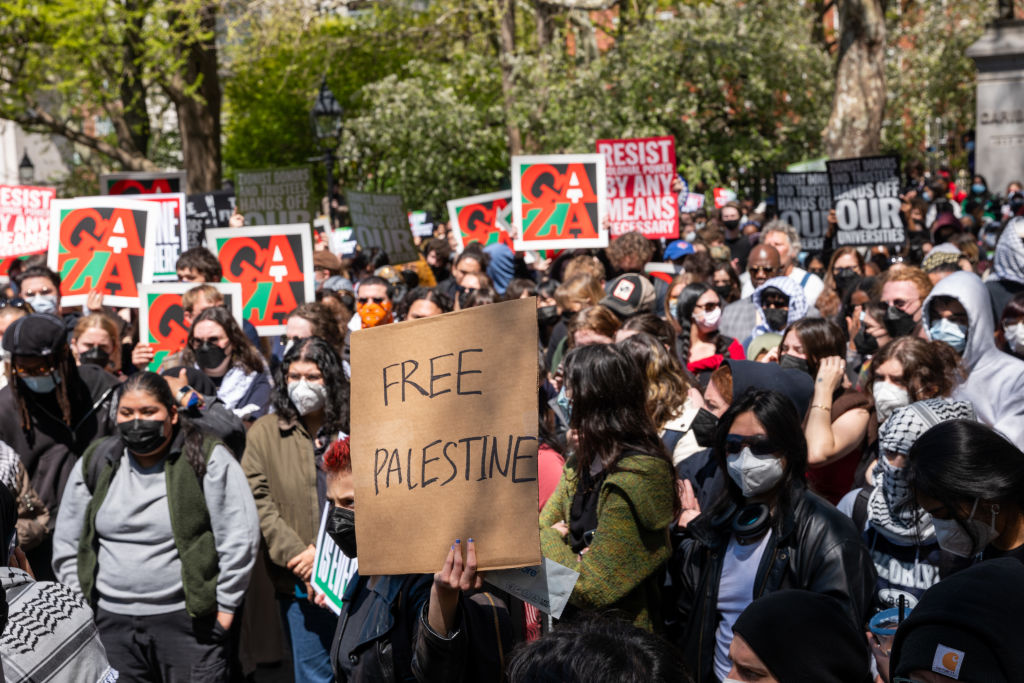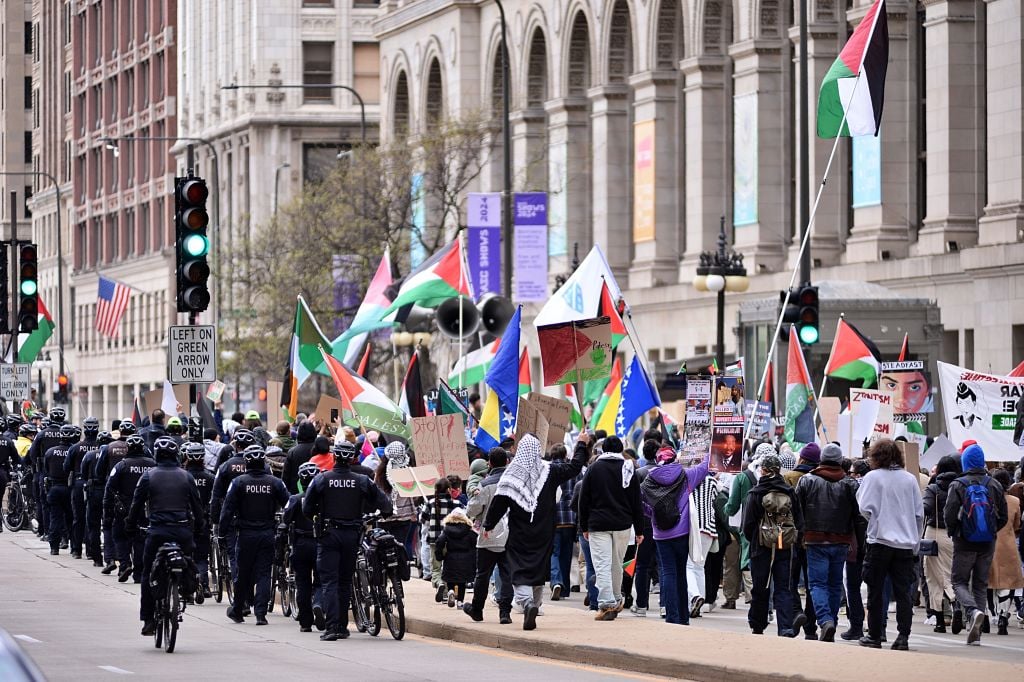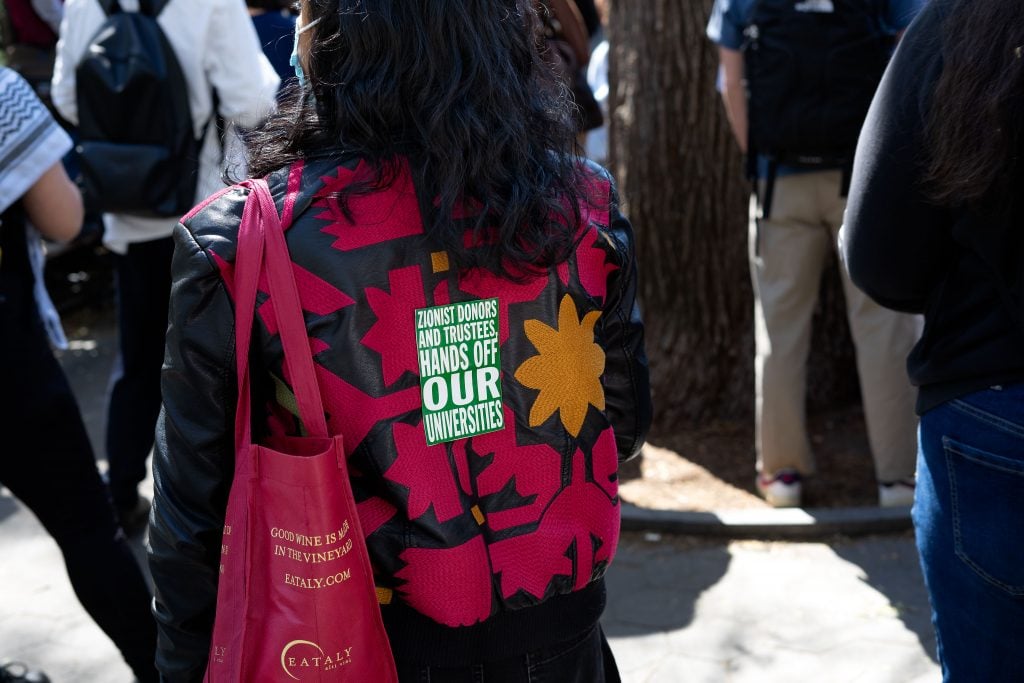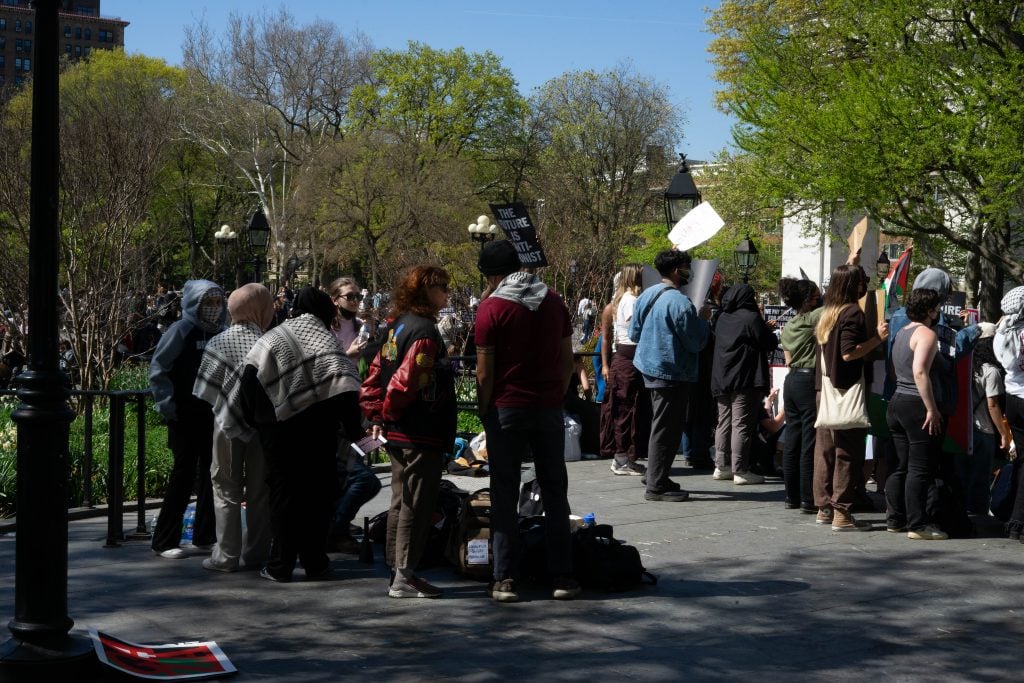Law & Politics
Art Students and Faculty Rally at U.S. University Pro-Palestine Protests
Artists have been at the forefront of organizing similar protests at museums and other institutions.

Artists have been at the forefront of organizing similar protests at museums and other institutions.

Adam Schrader &
Margaret Carrigan

As pro-Palestine protests have erupted on U.S. college campuses over the last week, protesters—including art students and faculty—have been joining the rallying calls for a ceasefire in Gaza and divestment from Israeli companies. Protests have spread to dozens of universities across the nation after an encampment on the campus of Columbia University in New York City led to the arrest and suspension of more than 100 protesters on April 18.
On Friday, April 26, protesters overtook the major intersection of Chicago’s Michigan Avenue and Adams Street, near the School of the Art Institute of Chicago, before being pushed to the neighboring Millennium Park by police. According to the Chicago Sun-Times, Rhoda Rosen, a curator and art history professor at SAIC who is Jewish and South African and who serves on the Advisory Council of the European Shoah Legacy Institute, spoke to the demonstrators.
“We support your vision of the School of The Art Institute of Chicago, and we believe that’s it’s achievable, a vision that imagines what it would be like to be a part of a community that divests from those funds that support the destruction of Palestinian culture,” Rosen said. “Know that calls for divestment from U.S. companies profiting from South African apartheid had a huge impact in South Africa.”

Pro-Palestinian demonstrators march through downtown Chicago to protest against Israeli attacks on Gaza. Photo: Jacek Boczarski/Anadolu via Getty Images.
Faculty at multiple universities have also issued statements of solidarity with university students. Members of Columbia’s Visual Arts and Music faculty issued a letter to students underscoring their constitutional right to assembly and free speech, according to a report by Hyperallergic. “We ask the University to revoke all suspensions, expunge the disciplinary records of sanctioned students, and immediately allow all students back into their dormitories,” the letter said.
At Princeton, faculty issued an open letter in solidarity, vowing to “withhold our academic labor from Columbia and Barnard, not to participate in conferences and other campus events, and not to collaborate with university institutions” until Columbia reinstated suspended students and removed police from campus to demonstrate the “unrestricted scholarly inquiry and academic freedom.” Signatories included art historians Hal Foster and Irene V. Small and artist James Welling, among others.
Since the protests broke out, students at multiple universities have been subject to police aggression and arrests in addition to academic censure.
Last week, at a New York University (NYU) protest in Washington Square Park, placards reading “GAZA” emulated Robert Indiana’s iconic Pop art piece, Love. Many art students who participated in organizing the demonstration declined to speak, citing their wishes to remain anonymous, fearing both legal and academic retribution for speaking to the media.

NYU students and activists protest Israel’s war in Gaza during Washington Square Park demonstration. Photo by Adam Schrader
When asked about the response by the New York Police Department at the university demonstrations, an artist who identified themselves only with the initials N.A. called it “disproportional.”
“The money that goes into these universities should go towards keeping them safe instead of using funds for enforcing violent police tactics,” she said, noting that parents should also be outraged. “If I was spending $100,000 to get my 19-year-old educated, I would be very upset if the school was just calling all these violent police officers to come in.”
Participants who were willing to speak also noted that they felt a moral obligation as artists to leverage their art as a platform for change. One NYU art student who provided the name Sol said that artists uniquely operate at the intersection of news, politics, and culture.
“The artist has to be with what’s happening and right now there is an escalation of genocide,” Sol said. “That means saying no to genocide and to the complete destruction and eradication of a whole group.”

NYU students and activists protest Israel’s war in Gaza during a Washington Square Park demonstration. Photo by Adam Schrader
Like a number of artists here, Sol said that they have incorporated responses to the war in Gaza into their creative practice. “There’s no separation between politics and art.”
Thomas Darmon, a 17-year-old high school student who stumbled upon a protest while meeting someone in Washington Square Park and decided to participate, said he plans to study animation at either the Pratt Institute or Sarah Lawrence College next year. He hypothesized that artists are visually minded and therefore impacted by the photojournalism coming from Gaza. “People are doing open heart surgery on a sidewalk with no anesthetic,” he said. “That being caught on camera—it sickens me a little bit.”

Susan Sarandon is pictured NYU students and activists protest Israel’s war in Gaza during Washington Square Park demonstration. Photo by Adam Schrader
Artists and arts workers have also spearheaded pro-Palestine demonstrations that have swept major institutions like the Metropolitan Museum of Art and Brooklyn Museum since the beginning of Israel’s offensive in Gaza, which has killed nearly 34,500 Palestinians, according to the Gaza Health Ministry. Hamas’s attack on Israel on October 7 killed 1,200 people in southern Israel and saw 240 taken hostage. The current surge in college campus protests has been called the most significant U.S. student movement since the Vietnam War campus protests of the late 1960s.